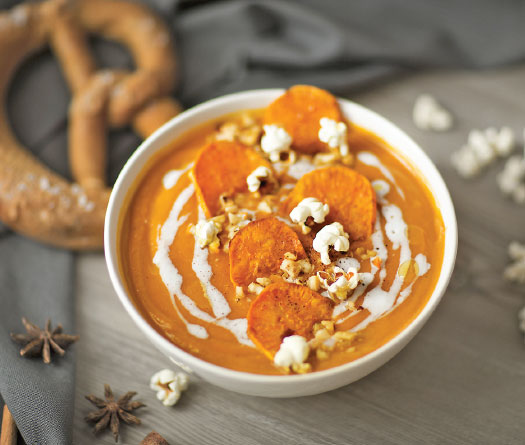Renaissance of the sweet potato
Editor's Note: Traditional and fusion cooking styles, regional and international ingredients and a new awareness of healthy eating are all factors contributing to an exciting time for Chinese cuisine. We explore the possibilities.
They say the first sweet potato vine was smuggled into China from what was then Dutch colony of Formosa, now known as Taiwan. A sailor had stripped off its leaves and secretly woven the vine into the hessian ropes on board the ship.
It first took root in Fujian province, the mainland territory nearest Taiwan island. Here, it flourished in the rocky, mountainous terrain where it helped to fill stomachs in a land too poor for paddy planting.
|
Sweet potato dessert soup with cream. Photos Provided to China Daily |
My grandfather, a native Fujianese before he was shipped to Singapore as a dockside coolie, remembered sweet potato porridge as the childhood staple. He told me his family was too poor to afford rice, so his mother cooked only porridge with chunks of sweet potatoes to fill the void.
Yet, years later, when he could indulge in meat and fish anytime he wanted, my grandfather chose to have sweet potato porridge every night for supper. That was the only hint he ever gave that he was thinking of home.
In the postwar years of the 1950s in Southeast Asia, sweet potatoes were a necessary staple in the era of a universal food shortage, and the enterprising cooks of my grandmother's generation thought up countless ways to cook the root.
They used it in rice and porridge, turned it into noodles, cooked it in sweet soups and made pies, dumplings, bread and cakes and little snacks from the humble root.
As the world and China connected more and more, the available varieties of sweet potatoes increased.
They were no longer just red-skinned and white-fleshed. There were large, honey-flavored ones with deep golden insides, tiny little ones that could be roasted whole and dried and candied, and deep purple ones that were burgundy both inside and out.
The sweet potato has endured as a favorite food.
It is one of the steamed staples in the autumn harvest basket, which includes purple yams, sweet and glutinous corn, Chinese yam, burdock and edamame, or green soybeans.
As the year progresses, a common winter sight all over China is the roasted sweet potato pushcart, with its huge barrel oven and a sweet burned-sugar fragrance rising from it.
Nothing chases the winter chills away better than a piping hot sweet potato in your hands, skin slightly burned and dotted with droplets of caramelized juices.
Processed sweet potato products include hard gray noodles that cook down to a translucent white that is much loved in winter hotpots. Sweet potato starch is a necessary ingredient in many desserts, as well as the secret to the signature oyster omelette famous in Fuzhou and the region of Chaoshan in Guangdong.
In recent years, an unexpected health fad - sweet potato leaves - has risen, thanks to the mighty webchat groups of bored housewives who consider themselves nutrition experts.
Although I have eaten sweet potato leaves as a vegetable from childhood, I was surprised to find they were considered a "new thing" in China.
I took great pleasure in teaching my sisters-in-law how best to prepare the leaves to make them palatable.
After harvesting, the leaves must be thoroughly washed to get rid of grit, since they grow low on the ground. Then the fibers must be stripped off the long stems, starting from the base of the leaf.
It is a fussy, tedious task, but necessary. Otherwise, the leaves will be too stringy to eat.
The next secret is to fry the aromatics like garlic, pounded dried prawns and chili well before adding the leaves. The wok must be on high heat, as the leaves will cook almost instantly and they turn unattractively dark if overcooked.
Sweet potatoes themselves are good boiled, steamed or deep-fried.
When I first came to Beijing, I always enjoyed the candied sweet potatoes my late brother-in-law used to make with nothing more than oil and loads of sugar. It was sweet on sweet, with the tender potatoes encased in a crisp, crunchy sugar candy coating.
Later on, I also discovered sweet potato chips in the local farmer's market. They were just as satisfying as the salty kind, and probably a lot healthier, too.
The sweet potato came from South America, but this "foreign potato" has certainly made China its second home.
paulined@chinadaily.com.cn
Enjoying a humble root
Sweet potato and meat pie
2-3 cooked sweet potatoes
500g minced meat (either pork, lamb, chicken or beef)
1 onion, diced, to be cooked with meat
1 clove garlic, chopped
1/2 cup sweet corn
100g beans, diced
100g carrots, diced
3 tablespoons butter or olive oil
Salt, pepper, oyster sauce
1/2 cup milk or stock
Blanch diced vegetables and corn in lightly salted water. That means dropping the vegetables into boiling water, counting till five, removing from heat and draining.
Heat up a spoonful of olive oil and saute the onions till transparent. Add garlic and continue to fry. Add minced meat and stir-fry till cooked and fragrant. Season with salt, pepper and oyster sauce.
Add blanched vegetables and mix well. Transfer filling into a deep baking tray or pie tin.
Mash the sweet potatoes, adding the butter and the milk or stock. Make sure it is nice and smooth. Spoon the mash onto the meat filling. Level off and then bake in 180-190 C oven for 30 minutes. Yummy.
Sweet potato dessert soup
2-3 large sweet potatoes
2-3 slices ginger
A handful of dried Chinese dates or jujubes
Rock sugar to taste
Skinned ginkgo nuts (optional)
Peel and cut the sweet potato into large chunks.
Heat up a pot of water till it boils, and add the sweet potato and ginger. Bring to a boil and add dried jujubes and ginkgo nuts (if using).
When the sweet potatoes start to turn soft, add rock sugar to taste. Boil for another five minutes till tender, and serve hot or cold.
The addition of the dried jujubes will add to the fragrance.



















